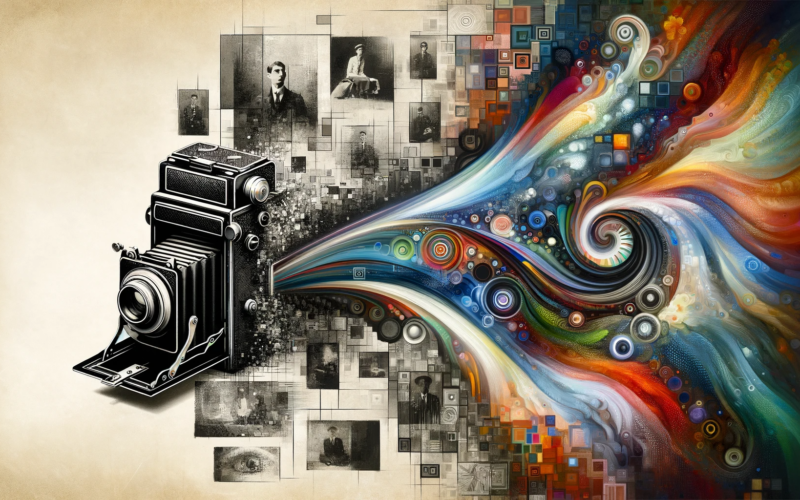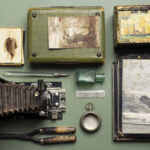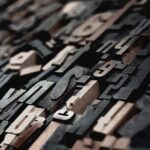The comparison between the advent of photography and the rise of Artificial Intelligence in the field of artistic creation offers an intriguing perspective on how technological innovations can challenge and redefine our understanding of art. Let’s begin by analyzing the historical debate over photography.
When photography made its appearance in the 19th century, many considered it a mere mechanical recording of reality. The notion that it was enough to “press a button” to capture an image seemed to diminish the artist’s role to that of a technician, lacking the creativity and interpretation that distinguish traditional art. However, over time, photography has been recognized as a fully-fledged artistic medium. Photography, evolving from a mere recording technique to an acknowledged art form, has seen the contribution of numerous artists, each bringing their unique and innovative vision. Beyond pioneers like Alfred Stieglitz and Ansel Adams, the photographic landscape has been enriched by contemporary photographers and avant-garde artists who have explored and often challenged the boundaries between photography and art.
Among the most influential names in the field of artistic photography is Cindy Sherman, known for her conceptual self-portraits in which she disguises herself in various identities. Her works explore themes of gender, identity, and society, using photography not just as a means of representation, but also as a tool for social critique and self-exploration.
Andreas Gursky is another prominent photographer, famous for his large-scale photographs depicting landscapes, architecture, and everyday life scenes. His works stand out for their meticulous aesthetics and the use of digital techniques to modify and intensify images, raising questions about truth and manipulation in photography.
A quintessential example of an artist using photography as a medium for his works is Vik Muniz, known for creating intricate images using unusual materials like sugar, chocolate, and waste. After composing these works, Muniz photographs them, making photography not just a means of capture but an integral part of the artwork itself.
Another significant example is Richard Prince, who has raised questions about ownership and authorship in art through his use of “re-photography”. Prince reinterprets others’ images, often advertisements and magazine photographs, through photography, challenging our notions of originality and plagiarism.
Finally, we mention Thomas Ruff, known for his photographic series exploring different styles and techniques, from abstract photography to digitally manipulated images. His work questions the role of the photographer in the digital age and the very nature of photographic representation.
These artists and many others have played a crucial role in expanding the concept of photography, pushing it beyond mere representation of reality, to explore and experiment with new ideas, materials, and techniques. Their work demonstrates how photography, like painting or sculpture, is a medium capable of profound artistic expression, capable of reflecting on itself and the world around it.
Today, we face a similar challenge with Artificial Intelligence, particularly with AI capable of generating images from textual descriptions. Some might argue that since AI produces images based on text input and a set of algorithms, this process lacks the human element that confers artistic value. However, this view overlooks the crucial role of human input in guiding and interpreting AI output.
Just like photography, the creation of images through AI can be seen as an extension of human artistic expression. The text input provided to AI is often the result of creative reflection, an attempt to explore themes, emotions, or concepts through the AI medium. In this sense, AI acts as a collaborator, a medium that translates creative intentions into visual images.
The use of Artificial Intelligence (AI) in art is a rapidly evolving field, with artists experimenting with this technology to explore new expressive frontiers. These artists use AI not just as a tool but as an integral part of the creative process, often generating debates about authorship and the nature of art.
One of the leading artists in this field is Refik Anadol, a media artist and creative director known for his data and AI-based installations. Anadol uses machine learning algorithms to transform large data sets into immersive visual art installations. His installations, like “Machine Hallucination” and “Data Sculpture for Melting Memories”, are examples of how AI can be used to create aesthetic experiences that blend art, architecture, and technology.
Another significant example is Mario Klingemann, an artist working with neural networks, machine learning, and algorithms. Known for his works exploring human perception and mechanical creativity, Klingemann uses AI to investigate the boundaries between human-made and machine-created art, pushing the limits of algorithmic creativity.
Sougwen Chung is an artist experimenting with collaboration between humans and AI systems. Through her project “Drawing Operations”, Chung works in tandem with a robotic arm that learns and replicates her drawing styles. This interaction explores the dynamics between the human and the artificial, challenging our understanding of co-creation and artistic innovation.
Hito Steyerl, an artist and theorist, uses AI in her works to explore themes such as surveillance, digitization, and the impact of technology on society. Her works often combine video, installations, and critical writings, posing incisive questions about the impact of AI and digital technologies on our lives and perception of reality.
Finally, Trevor Paglen, an artist and geographer, employs AI to investigate themes like mass surveillance and data collection. His works often explore the darker side of technology, exposing and critiquing the hidden structures of power and control behind surveillance and AI technologies.
These artists represent just a small selection of those exploring AI’s potential in art. Their work demonstrates how AI can not only be a tool for artistic creation but also a medium for raising important questions about technology, society, and the artist’s role in the digital age. Through their work, they offer new perspectives on how art can evolve and react in response to technological innovations.
It must be recognized, of course, that not all images generated via AI will be art, just as not all photographs or paintings are works of art. The key distinction lies in the author’s intent and vision. An AI-generated image can be as much an artistic expression as a photograph if there is a communicative intent, a desire to express or evoke something unique and personal.
In conclusion, both photography and image generation through AI challenge our traditional conceptions of what it means to create art. In both cases, technology acts as an extension of the artistic vision, allowing new forms of expression and interpretation. As with any artistic medium, it is the depth, intent, and ability to connect with viewers that determine the artistic value of a work, regardless of the medium used to create it.












